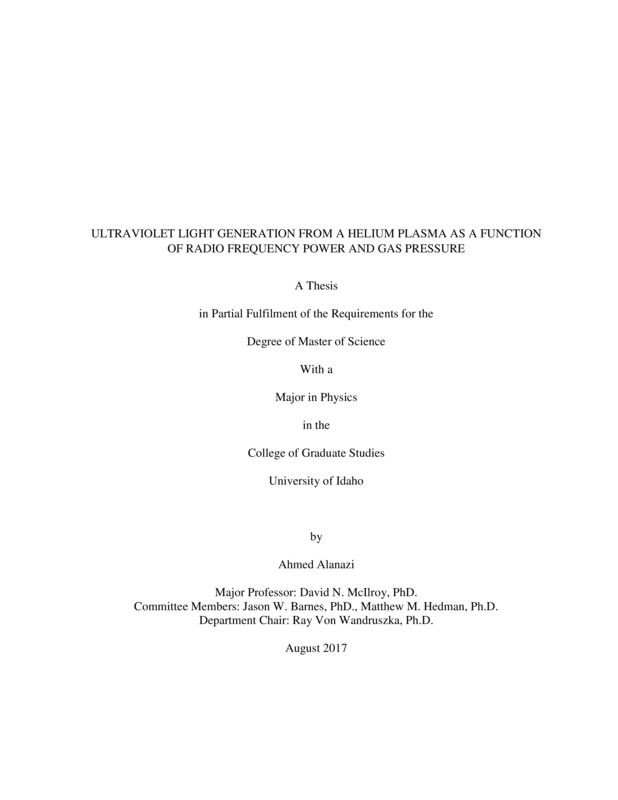Ultraviolet Light Generation from a Helium Plasma as a Function of Radio Frequency Power and Gas Pressure
Alanazi, Ahmed. (2017-08). Ultraviolet Light Generation from a Helium Plasma as a Function of Radio Frequency Power and Gas Pressure. Theses and Dissertations Collection, University of Idaho Library Digital Collections. https://www.lib.uidaho.edu/digital/etd/items/alanazi_idaho_0089n_11226.html
- Title:
- Ultraviolet Light Generation from a Helium Plasma as a Function of Radio Frequency Power and Gas Pressure
- Author:
- Alanazi, Ahmed
- Date:
- 2017-08
- Program:
- Physics
- Subject Category:
- Plasma physics
- Abstract:
-
Ultraviolet (UV) light emission is generated by exciting ground state helium to excited states, where the characteristic UV emission lines are referred to as the helium I and helium II emission lines. Excited He is achieved by pumping He gas with electromagnetic (EM) energy, where both ionized and excited He co-exist, known as a He gas plasma. The intensity UV emission by the He plasma increases with EM pumping power and the He gas pressure. Consequently, He plasmas are used as UV light sources. The highest intensity He UV light sources incorporate electron cyclotron resonance (ECR), where ECR increases the light intensity by increasing the probability of collision between the free electrons in the plasma with the He atoms. This class of high intensity UV light sources exclusively us microwaves to generate the He plasma. To the best of our knowledge, no one has attempted to use radio frequency (RF) EM radiation in high intensity UV light sources. Why not? RF plasmas are much easier to generate and control. All that is required is a simple electronic matching network for tuning the plasma, while a microwave plasma requires an antenna and a resonance chamber for tuning. In the present study, a high intensity He UV light source has been constructed using a ECR enhanced RF He plasma. Due to the absorption of low energy UV light by air, the emission and energy of the UV source has been indirectly measured by monitoring the photoelectron current of a gold target placed in the beam of the light source and rationalized by comparing to spectroscopy data reported for He plasmas. At low gas pressure the profile of the photocurrent consists of two pair of maxima. The pair of maxima in the low He gas pressure regime are assigned to the helium II emission lines with photon energies of 40.8 eV and 48.3 eV, respectively. In the high He pressure regime the pair of maxima are assigned to helium I emission lines at photon energies of 21.2 eV and 23.1 eV, respectively. Photocurrents of the order of a few pA have been obtained, as opposed to tens of nA for a traditional DC He UV light source.
- Description:
- masters, M.S., Physics -- University of Idaho - College of Graduate Studies, 2017-08
- Major Professor:
- McIlroy, David
- Committee:
- Barnes, Jason; Hedman, Matthew
- Defense Date:
- 2017-08
- Identifier:
- Alanazi_idaho_0089N_11226
- Type:
- Text
- Format Original:
- Format:
- application/pdf
- Rights:
- In Copyright - Educational Use Permitted. For more information, please contact University of Idaho Library Special Collections and Archives Department at libspec@uidaho.edu.
- Standardized Rights:
- http://rightsstatements.org/vocab/InC-EDU/1.0/

